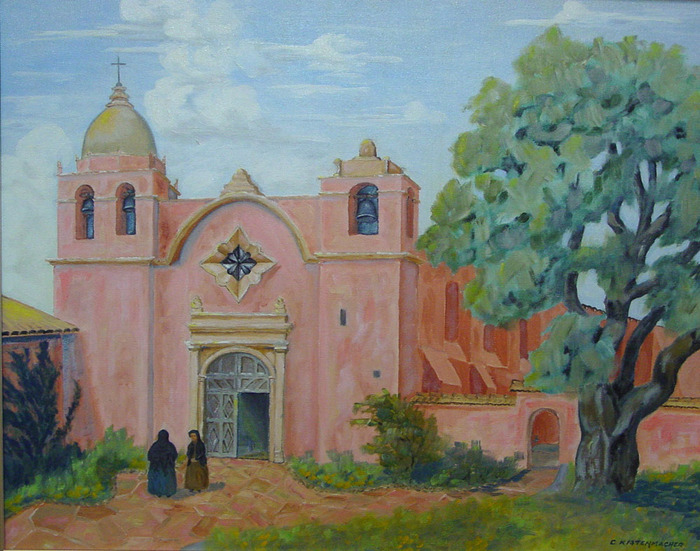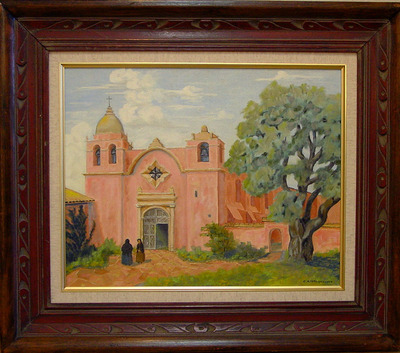Charles “Chile” Edward Kistenmacher (March 21, 1914 – May 1, 2004)
He was born in Sulphur Springs, Texas and grew up in Paris, Texas.
Charles, “Chile” to his close friends, attended public schools in Paris, Texas and thereafter enrolled in the School of Engineering at The University of Texas. He loved the game of golf and was very accomplished at it. He was the first winner of the Paris Country Club’s Championship Tournament and his name is still the first name on the Championship Trophy. He was, also, a member of the University’s Varsity Golf Team and although Varsity Golf was not a “Letter” sport back then, when it became a “Letter” sport, the University issued him a Varsity Letter and extended him membership in the T-Association, the University’s lettermen’s club. One of his engineering professors asked him, “Charles, do you intend to play golf for your livelihood or do you want to be an engineer because your golf game isn’t that good and you can’t do both?” He said that with that question, he had to redirect his efforts towards engineering.
Charles pledged Sigma Alpha Epsilon fraternity at the University and lived in the SAE house where he served meals to his frat brothers to help pay his way to the University. Later he became a “proof-reader” for the House of Representatives of the Texas State Legislature to help with school and for spending money.
Charles graduated from the University of Texas at Austin with a degree in Civil Engineering in 1935. Upon graduation, he was hired by Robert E. McKee General Contractor, Inc. of El Paso, Texas and was assigned to Pearl Harbor, Hawaii. He quickly married his childhood sweetheart, Eugenia Crook of Paris, Texas, and away they went. His first assignment with Robert E. McKee was to rebuild Scoffield Barracks at the Navel Base in Pearl Harbor.
While at Pearl Harbor he became interested in wood carving which was his first endeavor in the arts. He hand carved a table and several other pieces, found that he enjoyed it and realized that he had artistic talent and good with his hands.
Then came the bombing of Pearl Harbor. The couple lived on a hill in Honolulu, out of harm’s way, but they could see and take photos of the attack from their own backyard (which photos were later confiscated by the U.S. Government). They felt blessed that the bombing took place on Sunday and not a working day at the Base. The very next day the Base Commander sought out Charles and asked if he would survey the Base with him to assess the total damage. What a compliment in such a dire situation. With his construction project in ruins and the U.S. at war with Japan, they were sent back to the U.S. by ship. It took them about three weeks at sea, dodging submarines and enemy war ships, before they landed on home soil. The couple moved to Solvang, California and Ogden, Utah with Robert E. McKee for short periods of time before they moved to McKee’s home office in El Paso. During this period of time, the R.E. McKee organization was considered the third largest construction company in the world.
After about 25 years of service with R.E. McKee General Contractor, Charles started his own construction company. His business reputation was that of a tough but honest, no nonsense professional engineer that brought his jobs in on time, within the allotted budget and without compromise. During all this time he continued to play golf at the El Paso Country Club (EPCC) with a regular group that included several high profile architects and the president of the El Paso Natural Gas Company. One year he was the Runner-Up in the EPCC Club Championship. As an aside note to that particular Championship Match, when Charles missed an important putt, he threw his putter. No he didn’t drown it in the water hazard but he did get it stuck in a tree. He had to send his caddy up into the tree to retrieve his club. He was terribly embarrassed by that show of emotion but kept right on playing. Several years later, he bought a residential lot in the newly developed Coronado Country Club addition to El Paso where he became a Charter Member of that country club.
In addition to golf and hard work, Charles was an avid fly fisherman. He looked forward to spending two weeks in the summers at a guest ranch outside of Bayfield, Colorado with his family where he could fish the Pine River and the beaver ponds on the ranch every day. The kids went on horseback rides while Charles and Genie went fly fishing. Often times, when they were in Colorado, they would get up early and go fishing with a skillet in hand. They would then catch their breakfast, build a small fire and cook fresh trout right there beside the river. That was as close to “Heaven” as they could get on this earth.
After nine years he closed his own business and went back to R.E. McKee, Inc. as the Senior Vice President and Division Manager, a very demanding position. By then the game of golf began to hurt his back to the point that he just couldn’t play good golf any more, and if he couldn’t play good golf, he lost interest in the game. This was a very unsettling time for Charles. Golf wasn’t fun, he hadn’t started art yet as a way to relax and he had all the business pressure from selling his own business to learning his new position with McKee. His son Eric was enrolled in college at this same time and was struggling with knowing what to get his degree in. Then one night, after a particularly stressful day at the office, Charles told Eric to go to his room, shut the door and don’t come out until he knew exactly what he wanted to be for the rest of his life. Spoken like a true engineer. Eric’s response as best he can remember was, “Could you slip some bread crumbs and water under the door just occasionally?”
In 1967 with Genie’s encouragement, Charles turned to his lifelong interest in art and began to take artistic painting lessons from the Bavarian portrait and landscape artist, Louis Krupp. He became a “weekend painter” but only in the sense that his time at the easel was restricted to his leisure time. That time became increasingly more important to him to become an accomplished artist and he devoted himself to this end as only an engineer could do. He studied under Mr. Krupp every Saturday morning for more than 10 years.
A talent which had laid dormant all his life awoke as he mastered basic techniques, and for the rest of his life, even while still working at R.E. McKee and especially after he retired from work in 1982, he continued to study, to learn and to explore new media and new forms of painting. He enjoyed portraiture and in particular the challenge of depicting the strength and mystery of the Indian and the Mexican face. He, also liked the bold impasto of the palette knife and, conversely, the delicacy possible with water color. Whenever he traveled, as he and Genie did frequently, to Maine (Kennebunkport), New Mexico, Colorado, Arizona, Idaho, old Mexico, China, Europe and Portugal, he always took along his camera and sketch pad to bring home raw material to convert into paintings in his studio. He loved landscapes and the strength of a strong sea in his seascapes, but above all, Charles did not want to be known as a typical “southwestern” artist.
He participated in workshops with such widely known artists as Sergi Bongart, Ken Gore, Ben Konis, Charles Reed, Paul Strisik, Edgar Whiting, Charlotte Blass and Dr. Robert Massey.

